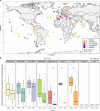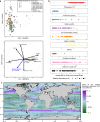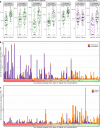Genomic adaptation of the picoeukaryote Pelagomonas calceolata to iron-poor oceans revealed by a chromosome-scale genome sequence
- PMID: 36114260
- PMCID: PMC9481584
- DOI: 10.1038/s42003-022-03939-z
Genomic adaptation of the picoeukaryote Pelagomonas calceolata to iron-poor oceans revealed by a chromosome-scale genome sequence
Abstract
The smallest phytoplankton species are key actors in oceans biogeochemical cycling and their abundance and distribution are affected with global environmental changes. Among them, algae of the Pelagophyceae class encompass coastal species causative of harmful algal blooms while others are cosmopolitan and abundant. The lack of genomic reference in this lineage is a main limitation to study its ecological importance. Here, we analysed Pelagomonas calceolata relative abundance, ecological niche and potential for the adaptation in all oceans using a complete chromosome-scale assembled genome sequence. Our results show that P. calceolata is one of the most abundant eukaryotic species in the oceans with a relative abundance favoured by high temperature, low-light and iron-poor conditions. Climate change projections based on its relative abundance suggest an extension of the P. calceolata habitat toward the poles at the end of this century. Finally, we observed a specific gene repertoire and expression level variations potentially explaining its ecological success in low-iron and low-nitrate environments. Collectively, these findings reveal the ecological importance of P. calceolata and lay the foundation for a global scale analysis of the adaptation and acclimation strategies of this small phytoplankton in a changing environment.
© 2022. The Author(s).
Conflict of interest statement
The authors declare no competing interests.
Figures





References
-
- Agawin NSR, Duarte CM, Agustí S. Nutrient and temperature control of the contribution of picoplankton to phytoplankton biomass and production. Limnol. Oceanogr. 2000;45:591–600. doi: 10.4319/lo.2000.45.3.0591. - DOI
Publication types
MeSH terms
Substances
LinkOut - more resources
Full Text Sources
Medical

